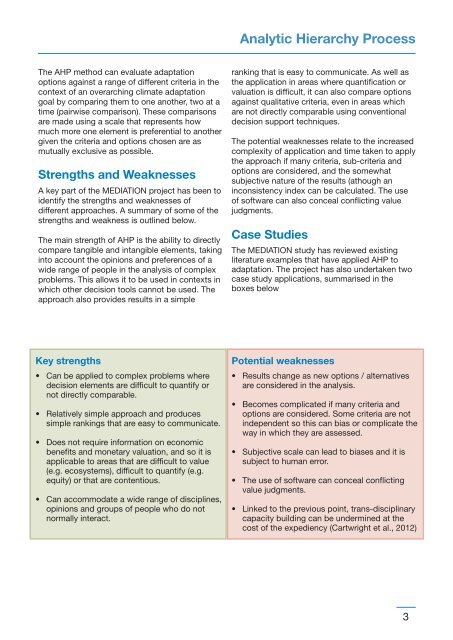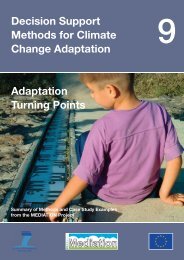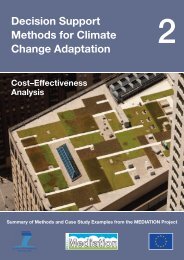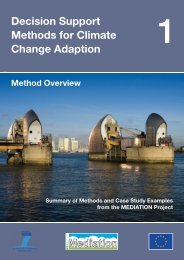DecisionSupport 7uses numerical values (e.g. as <strong>in</strong> the scale below)to conduct the pairwise comparisons,construct<strong>in</strong>g a set of pairwise comparisonmatrices. Several matrices are produced tocompare the alternatives (e.g. adaptationoptions) with respect to each criteria, and thecriteria with respect to the goal.4. Calculate relative priorities. This can be doneus<strong>in</strong>g a spreadsheet, or software, such asExpertChoice. 1 The values <strong>in</strong> Step 3 areprocessed to obta<strong>in</strong> numerical priorities orweights for the criteria and alternatives.Depend<strong>in</strong>g on the problem at hand, a priority orweight can refer to importance, preference orlikelihood.5. Aggregate priorities. The f<strong>in</strong>al step is toaggregate relative priorities to produce over<strong>all</strong>priorities (f<strong>in</strong>al evaluation metrics) which sum to1.0.The Application to AdaptationAHP has been used <strong>in</strong> a wide variety of fields<strong>in</strong>clud<strong>in</strong>g eng<strong>in</strong>eer<strong>in</strong>g, bus<strong>in</strong>ess strategicmanagement, education and quality assessment.The approach has high relevance for the analysisof climate adaptation related decisions, given itis useful where a range of stakeholders aredeal<strong>in</strong>g with issues that have a high degree ofcomplexity, that <strong>in</strong>volve uncerta<strong>in</strong>ty and risk, and<strong>in</strong>clude subjectivity, i.e. human perceptions andjudgments. It is also potenti<strong>all</strong>y useful when theoutcomes have possible long-termconsequences (Bhushan, 2004).The tool has a particular relevance whereimportant elements of the decision are difficult toquantify or compare, or where different expertise,goals, and world-views are a barrier toconsensus-build<strong>in</strong>g and communication.In the context of climate adaptation, the methodcan be used to compare a set of adaptationoptions aga<strong>in</strong>st a set of def<strong>in</strong>ed criteria us<strong>in</strong>gparticipants’ experience and judgment about theissues of concern. It <strong>all</strong>ows the comparison ofdiverse elements that are often difficult tomeasure <strong>in</strong> a structured and systematic wayus<strong>in</strong>g a scale. This makes it particularly relevantfor sectors or key criteria where quantification isch<strong>all</strong>eng<strong>in</strong>g.The first applications of the approach to climatechange were <strong>in</strong> the context of the globalnegotiations on climate change (Ramanathan,1998) and later <strong>in</strong> mitigation policy <strong>in</strong>struments(Konidari and Mavrakis, 2007). AHP is now<strong>in</strong>creas<strong>in</strong>gly be<strong>in</strong>g applied <strong>in</strong> the area of climatechange adaptation. It was applied us<strong>in</strong>g aparticipatory approach for the <strong>in</strong>tegration of<strong>in</strong>digenous knowledge with<strong>in</strong> adaptationstrategies <strong>in</strong> the Tabasco Pla<strong>in</strong>s of Mexico(Ponce-Hernandez and Patel, forthcom<strong>in</strong>g), <strong>in</strong>the evaluation of adaptation options for humansettlements <strong>in</strong> South East Queensland (Choy etal., 2012), <strong>in</strong> the <strong>in</strong>tegration of GIS modell<strong>in</strong>g tolook at crop impacts <strong>in</strong> Australia (Sposito, 2006)and to explore the impacts of storm surge andsea level rise <strong>in</strong> Canada and Caribbean (Laneand Watson, 2010). Y<strong>in</strong> et al (2008) applied AHPto evaluate adaptation options for the watersector <strong>in</strong> the Heihe River Bas<strong>in</strong> <strong>in</strong> north-westernCh<strong>in</strong>a, result<strong>in</strong>g <strong>in</strong> a higher preference for<strong>in</strong>stitutional options for manag<strong>in</strong>g water demand(impos<strong>in</strong>g constra<strong>in</strong>ts on large consumers, waterconservation <strong>in</strong>itiatives through water userassociations, and transferrable water <strong>all</strong>ocationpermits), rather than ‘hard’ eng<strong>in</strong>eer<strong>in</strong>g optionsfor <strong>in</strong>creas<strong>in</strong>g water supply.1http://expertchoice.com/2
Analytic Hierarchy ProcessThe AHP method can evaluate adaptationoptions aga<strong>in</strong>st a range of different criteria <strong>in</strong> thecontext of an overarch<strong>in</strong>g climate adaptationgoal by compar<strong>in</strong>g them to one another, two at atime (pairwise comparison). These comparisonsare made us<strong>in</strong>g a scale that represents howmuch more one element is preferential to anothergiven the criteria and options chosen are asmutu<strong>all</strong>y exclusive as possible.Strengths and WeaknessesA key part of the MEDIATION project has been toidentify the strengths and weaknesses ofdifferent approaches. A summary of some of thestrengths and weakness is outl<strong>in</strong>ed below.The ma<strong>in</strong> strength of AHP is the ability to directlycompare tangible and <strong>in</strong>tangible elements, tak<strong>in</strong>g<strong>in</strong>to account the op<strong>in</strong>ions and preferences of awide range of people <strong>in</strong> the analysis of complexproblems. This <strong>all</strong>ows it to be used <strong>in</strong> contexts <strong>in</strong>which other decision tools cannot be used. Theapproach also provides results <strong>in</strong> a simplerank<strong>in</strong>g that is easy to communicate. As well asthe application <strong>in</strong> areas where quantification orvaluation is difficult, it can also compare optionsaga<strong>in</strong>st qualitative criteria, even <strong>in</strong> areas whichare not directly comparable us<strong>in</strong>g conventionaldecision support techniques.The potential weaknesses relate to the <strong>in</strong>creasedcomplexity of application and time taken to applythe approach if many criteria, sub-criteria andoptions are considered, and the somewhatsubjective nature of the results (athough an<strong>in</strong>consistency <strong>in</strong>dex can be calculated. The useof software can also conceal conflict<strong>in</strong>g valuejudgments.Case StudiesThe MEDIATION study has reviewed exist<strong>in</strong>gliterature examples that have applied AHP toadaptation. The project has also undertaken twocase study applications, summarised <strong>in</strong> theboxes belowKey strengths• Can be applied to complex problems wheredecision elements are difficult to quantify ornot directly comparable.• Relatively simple approach and producessimple rank<strong>in</strong>gs that are easy to communicate.• Does not require <strong>in</strong>formation on economicbenefits and monetary valuation, and so it isapplicable to areas that are difficult to value(e.g. ecosystems), difficult to quantify (e.g.equity) or that are contentious.• Can accommodate a wide range of discipl<strong>in</strong>es,op<strong>in</strong>ions and groups of people who do notnorm<strong>all</strong>y <strong>in</strong>teract.Potential weaknesses• Results change as new options / alternativesare considered <strong>in</strong> the analysis.• Becomes complicated if many criteria andoptions are considered. Some criteria are not<strong>in</strong>dependent so this can bias or complicate theway <strong>in</strong> which they are assessed.• Subjective scale can lead to biases and it issubject to human error.• The use of software can conceal conflict<strong>in</strong>gvalue judgments.• L<strong>in</strong>ked to the previous po<strong>in</strong>t, trans-discipl<strong>in</strong>arycapacity build<strong>in</strong>g can be underm<strong>in</strong>ed at thecost of the expediency (Cartwright et al., 2012)3





